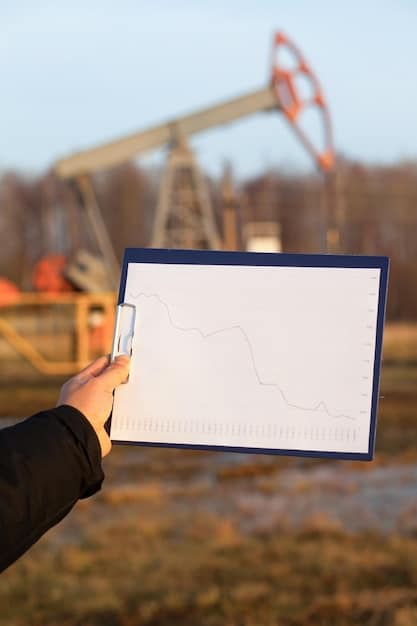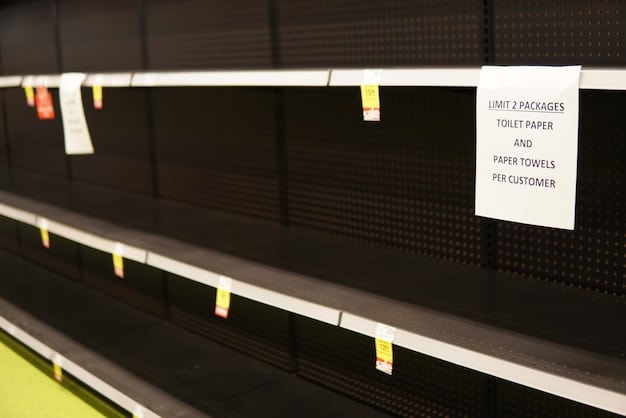Oil Prices Hit $85: Analyzing the Impact on Consumers & Industries

Oil prices have surged to $85 a barrel, triggering widespread concerns about the potential impact on transportation costs, consumer goods prices, and the overall economic stability in the United States.
The recent surge in oil prices to $85 a barrel: Impact on Transportation and Consumer Goods is sending ripples through the US economy. Consumers and businesses alike are bracing for potential increases in various sectors. Let’s delve into the key areas affected by this price hike.
Understanding the Oil Price Surge
The rise in oil prices to $85 a barrel is driven by a complex interplay of factors. Geopolitical tensions, supply constraints, and increasing global demand are all contributing to the upward pressure on prices. Understanding these factors is crucial to grasping the potential consequences for the US economy.
Geopolitical Tensions and Supply Disruptions
Ongoing conflicts and political instability in key oil-producing regions can significantly disrupt the supply chain. These disruptions often lead to increased volatility in the oil market, pushing prices higher.
Global Demand and Economic Growth
As economies around the world recover from the pandemic, the demand for oil is steadily increasing. This increased demand, coupled with limited supply, further contributes to the upward pressure on oil prices.
Several factors are causing the present surge
- Increased global demand due to recovering economies
- Supply chain disruptions caused by geopolitical tensions
- OPEC+ production cuts aimed at stabilizing prices
- Seasonal factors like increased travel during summer months
In conclusion, the current surge in oil prices is a result of both supply-side constraints and demand-side pressures. Understanding these factors is essential for predicting future price movements and their potential impact on the economy.

Impact on Transportation Costs
Transportation is one of the most directly impacted sectors by rising oil prices. Higher fuel costs for trucking, aviation, and shipping translate into increased expenses for businesses and consumers alike. This impact cascades through the supply chain, affecting the prices of goods and services across the board.
Fuel Surcharges and Delivery Fees
Transportation companies often impose fuel surcharges to offset the rising cost of fuel. These surcharges are passed on to consumers in the form of higher delivery fees and shipping costs.
Airline Ticket Prices
Airlines are also sensitive to changes in oil prices, as fuel represents a significant portion of their operating expenses. Higher oil prices typically lead to increased airline ticket prices, making travel more expensive for consumers.
Specifically, we can consider the following points:
- Increased fuel surcharges for trucking and shipping
- Potential increases in airline ticket prices
- Higher costs for ride-sharing services and public transportation
In conclusion, the impact of rising oil prices on transportation costs is significant and far-reaching. Consumers and businesses should anticipate higher expenses related to transportation in the coming months.
Effects on Consumer Goods Prices
The impact of rising oil prices extends beyond transportation and affects the prices of a wide range of consumer goods. From groceries to clothing, many products rely on oil for their production, packaging, and distribution. As oil prices increase, manufacturers and retailers are forced to pass on these costs to consumers.
Increased Manufacturing Costs
Oil is a key ingredient in the production of many plastics, chemicals, and synthetic materials. Higher oil prices increase the cost of these inputs, driving up the manufacturing costs for a wide range of consumer goods.
Higher Packaging and Distribution Expenses
The packaging and distribution of consumer goods also rely heavily on oil. Higher fuel costs for transportation and increased costs for packaging materials contribute to higher prices for consumers.

Here are some sectors more affected by oil prices:
- Groceries and food products
- Clothing and apparel
- Household goods and appliances
In conclusion, the rise in oil prices has a broad impact on the prices of consumer goods. Consumers should expect to see higher prices for a wide range of products in the coming months.
Potential Impact on Inflation
The surge in oil prices can contribute to broader inflationary pressures in the economy. As transportation costs and consumer goods prices increase, the overall cost of living rises. This can lead to a decrease in consumer spending and slower economic growth.
Cost-Push Inflation
Rising oil prices can trigger cost-push inflation, where businesses increase prices to offset higher input costs. This type of inflation can be particularly challenging to manage, as it is driven by supply-side factors rather than demand-side factors.
Impact on Monetary Policy
Central banks may respond to rising inflation by raising interest rates. Higher interest rates can help to cool down the economy and curb inflation, but they can also lead to slower economic growth and increased borrowing costs for consumers and businesses.
The increased oil prices will directly affect:
- Overall inflation rates
- Consumer purchasing power
- Central bank monetary policy decisions
In conclusion, the potential impact of rising oil prices on inflation is a significant concern for policymakers and economists. Managing inflation while maintaining economic growth will be a key challenge in the coming months.
Strategies for Businesses and Consumers
In the face of rising oil prices, businesses and consumers can adopt various strategies to mitigate the impact on their bottom lines. From energy efficiency measures to smart purchasing decisions, there are ways to adapt to the changing economic landscape.
Energy Efficiency Measures
Businesses can invest in energy-efficient equipment and practices to reduce their reliance on oil. This can include upgrading to more efficient vehicles, optimizing transportation routes, and implementing energy-saving technologies in their facilities.
Smart Purchasing Decisions
Consumers can make smart purchasing decisions to reduce their exposure to rising oil prices. This can include carpooling and using public transportation, buying fuel-efficient vehicles, and reducing unnecessary travel.
Key points about business and consumers actions:
- Invest in energy-efficient technologies
- Optimize transportation and logistics
- Reduce unnecessary travel and consumption
- Explore alternative energy sources
In conclusion, businesses and consumers can take proactive steps to mitigate the impact of rising oil prices. By adopting energy-efficient practices and making smart purchasing decisions, they can navigate the challenges and minimize the effect on their wallets.
Long-Term Outlook and Alternative Energy
The long-term outlook for oil prices remains uncertain, but it is clear that the world needs to transition towards more sustainable energy sources. Investing in alternative energy technologies and reducing our reliance on fossil fuels is essential for long-term economic and environmental sustainability.
Investment in Renewable Energy
Governments and businesses should prioritize investment in renewable energy sources such as solar, wind, and hydro power. These technologies offer a clean and sustainable alternative to fossil fuels and can help to reduce our vulnerability to oil price fluctuations.
Policy Support for Alternative Energy
Governments can play a crucial role in supporting the development and deployment of alternative energy technologies through policies such as tax incentives, subsidies, and regulations. These policies can help to level the playing field and accelerate the transition to a cleaner energy future.
More points about alternative energy:
- Increased investment in renewable energy technologies
- Policy support for alternative energy sources
- Infrastructure development for electric vehicles and charging stations
In conclusion, the long-term solution to rising oil prices lies in transitioning to a more sustainable energy future. By investing in alternative energy technologies and adopting supportive policies, we can reduce our reliance on fossil fuels and create a more resilient economy.
| Key Point | Brief Description |
|---|---|
| ⛽Surge Drivers | Geopolitical tensions and increased global demand are pushing oil prices up. |
| ✈️ Transportation Impact | Higher fuel costs lead to increased expenses for trucking, aviation, and shipping. |
| 🛍️ Consumer Goods Prices | Manufacturing, packaging, and distribution costs increase, affecting retail prices. |
| 🌱 Alternative Energy | Investing in sustainable sources is crucial for long-term economic stability. |
Frequently Asked Questions
The surge is primarily due to a combination of increased global demand as economies recover and supply constraints caused by geopolitical tensions. Production cuts by OPEC+ nations also play a role.
Higher oil prices directly impact fuel costs for trucking, aviation, and shipping, leading to increased delivery fees and higher airline ticket prices for consumers.
Groceries, clothing, and household goods are significantly affected. Increased manufacturing, packaging, and distribution costs drive up retail prices for these products.
Businesses can invest in energy-efficient technologies and optimize logistics. Consumers can reduce travel, use public transport, and purchase fuel-efficient vehicles to minimize their exposure.
Transitioning to sustainable energy sources like solar, wind, and hydro power is crucial. Policy support for alternative energy and infrastructure development are essential steps toward a cleaner energy future.
Conclusion
The surge in oil prices to $85 a barrel: Impact on Transportation and Consumer Goods presents challenges for both consumers and businesses in the US. Understanding the underlying factors, potential consequences, and available strategies is crucial for navigating these economic shifts effectively. By adopting energy-efficient practices and investing in sustainable alternatives, we can mitigate the impact and build a more resilient economy.





